by Kary Pardy
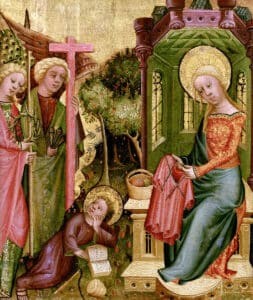
Courtesy of Wikimedia Commons.
Knitting is everywhere recently. Creating warm hats, scarves, wraps, sweaters, and mittens is currently a fashionable pastime for people of all ages, and skilled knitters can create art with their complex stitches and colors. When you ask people in 2020 what knitting is to them, you’re likely to get answers like “it’s a soothing activity,” “something to do with my hands,” or “a way to create gifts for those I love.” If you like knitting now and you are considering it as a collecting interest, I’m here to tell you that knitting is much more than a cathartic pastime. It’s an innovation that has been around for thousands of years and remains largely unchanged. Knitwear is also a fascinating direction to take your textile collection.
First, let’s look at what knitting is and how it technically compares to its other cloth art sister, weaving. Knitting is the manipulation of a thread to form loops and stitches that run together consecutively to make a cloth. Weaving involves interlacing two strands together to make a cloth. Though similar, we’re going to focus on knitting and it’s strength – knitting can be 3D.
History
Knitting has its origins in Ancient Egypt and China, and amazingly, ancient examples are structurally unchanged from the knitting that we do today. Anthropologists surmise that knitting was invented because of something that seems simple – a sock. More specifically, humans needed a way to create a cloth that could wrap around feet, and do so while accommodating different shapes and sizes. With knitting, you could create something that surrounded the entire foot and stretched as needed, and thus the knit sock was born and we never looked back.
Muslim craftsmen brought knitting to Europe in the 12th and 13th centuries where it appears it was held in high regard; several quality knit items were found in tombs and church treasuries across Spain. It spread to the rest of Europe with Christianity and was considered a holy enough craft that sometimes you can spot the Virgin Mary knitting in Middle Age paintings.
Mary was the last woman to be praised for knitting for a long time. As knitting gained popularity in the 15th and 16th centuries, it took on two sectors: peasant men and women knitting for an income or clothing for their families, or fine luxury knitting, which was strictly the purview of men. Knitting schools helped poor men break out of poverty, and knitting guilds offered aspiring knitters a reliable and in-demand trade if they could withstand six years of training. Hopefuls spent three years as apprentices and three as journeymen, ideally traveling to learn new patterns and techniques. The final exam lasted thirteen weeks and asked participants to complete a hat, a pair of gloves or stockings, a garment, and a knitted carpet.
Even though the mechanical knitting machine was invented in 1589, the majority of knitwear was not factory produced until steam-powered machines made bulk operations possible, and the divergence between individual laborers and shops increased even further – by the 19th century most knitwear was factory produced and hand-knitting became the realm of ladies of leisure who picked up needlework crafts as a
pastime, a more recognizable pattern in today’s world.
Collecting Knits
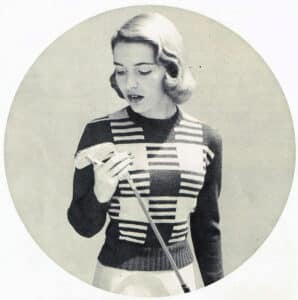
Courtesy of HoneyCombPatterns, Etsy.
Are you a knitter or does the practice’s ancient history draw you in? Fortunately, there are lots of collecting directions you can take. Whether you focus on tools (knitting needles, cases for knitting needles, knitting sheaths, guards, yarn holders, skein winders, scissors, and measurement tools, etc.) or collect knitwear fashions through the years, there are lots of options for you and the field is not heavily saturated. There’s much more to learn and explore.
Let’s start with knitting tools and the most obvious, knitting needles. Early needles were called “wires” or “pins,” and while the function was the same, they were simplistic compared to modern needles that have evolved for comfort and ease. These metal pieces were cheaply made and can add a bit of history and folk appeal to your collection, but won’t add much beauty. You will start to see finer knitting needle designs during the Victorian era, when people, mainly middle to upper-class women, could afford such luxuries. Keep an eye out for silver, bone/ivory, whalebone, and tortoiseshell needles, sometimes with sterling accents or guards. These attractive options traded function for beauty; they did not have the same fine gauge as steel wires and poor people knitting for a living continued to use the more agile option.
Rubber, celluloid, and casein needles appeared on the market in the late 1800s, and Bakelite examples joined them in 1909. Wood was also an option through the ages. If needle collecting interests you, but sure to check out Webster’s Knitting Needle Notions online for a list of brands and styles through the years and photographs to guide you in finding the right vintage pair (or several!).
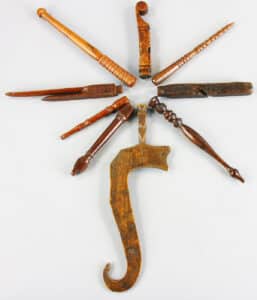
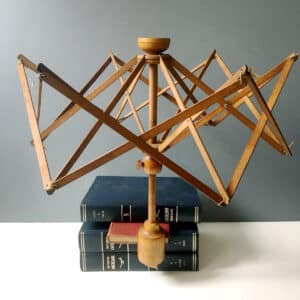
Knitting sheaths are no longer commonly used but were very helpful when craftsmen needed to speed knit while standing up. They were traditionally carved from wood and would be worn on the belt on the right side to support a right-handed knitting needle. The knitter would work with the mounted needle and pass stitches off of the left needle down onto the right. Wealthy women in the 17th century and later also adopted sheaths. You can find them in ivory, scrimshaw, and from silver to wood, some with decorations or messages.
Do you prefer the fashion side of knitting? Knitting patterns and “recipes” first appeared for public consumption in the early 1800s. You can collect patterns through the years, including wartime “Knitting for Victory” examples. During World War II, women were encouraged by advertising such as “England expects – knit your bit,” and patterns were freely distributed to housewives and schoolchildren. The Victoria and Albert Museum offers free patterns for “The Fatigue Cap” and “When You’re Off-Duty Jumper” among others. Early patterns are more difficult to track down and may lead a dedicated collector on a bit of an ephemera treasure hunt.
Knitting is rapidly developing a following and this arena may not remain quiet for long. With young people and trendsetters picking up the needles and events such as the 2006 Knitting Olympics with over 4,000 participants, the recognition that knitting is an ancient and still well-loved craft may drive an increasing interest in vintage knitting collectibles. There is still much to learn, but don’t let that stop you! Why not learn to use a knitting sheath, or hunt down the perfect pair of Victorian needles? A craft can be extra satisfying when you have a complete set of tools, and with centuries of options to choose from, you can’t go wrong.

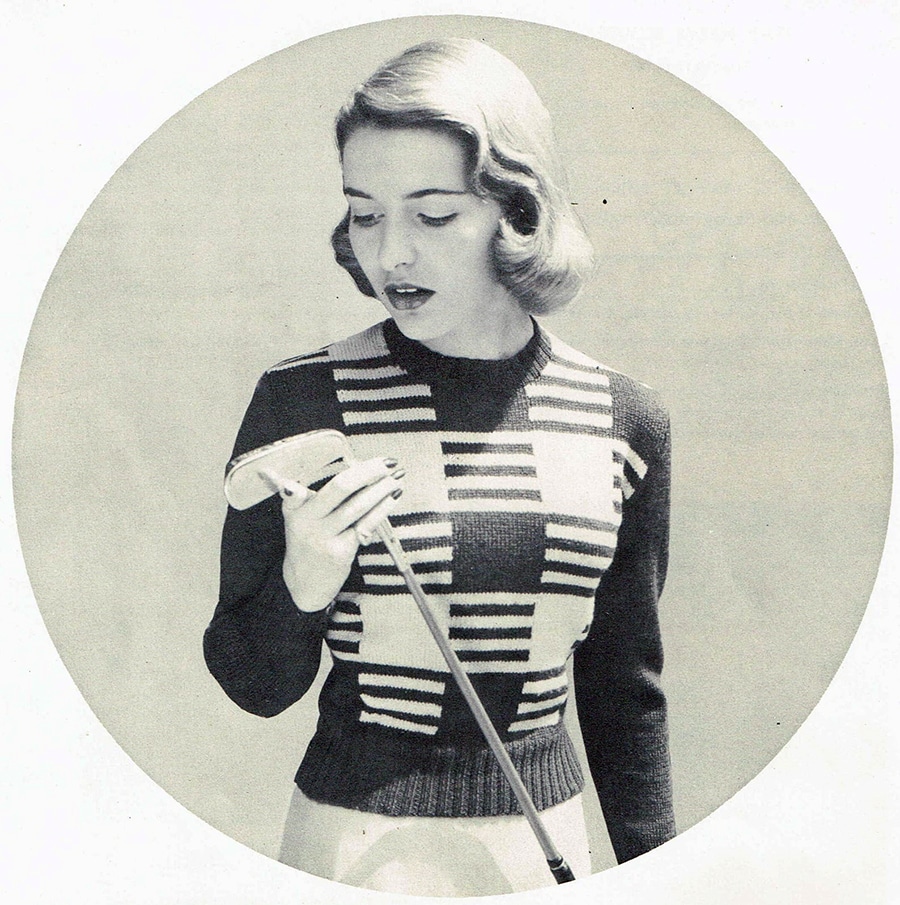



Related posts: